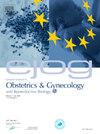早产儿羊膜内感染和/或炎症的治疗策略
IF 1.7
Q3 OBSTETRICS & GYNECOLOGY
European Journal of Obstetrics and Gynecology and Reproductive Biology: X
Pub Date : 2025-06-08
DOI:10.1016/j.eurox.2025.100408
引用次数: 0
摘要
自发性早产(sPTB)是由多种因素引起的;然而,主要原因是羊膜内感染和/或炎症。极度sPTB(28周)羊膜内感染/炎症的频率更高,并导致长期认知障碍,如脑瘫和智力低下。羊膜内重复感染的发生率,如脲原体/支原体和细菌,在sPTB <; 妊娠27周时较高。需要基于羊膜内感染/炎症的准确信息的产科策略来预防sPTB(特别是极度sPTB)并改善早产儿的长期预后。我们的PCR方法,这是敏感的,无假阳性,准确识别是否羊膜内感染存在。适当的抗生素治疗羊膜内感染(大环内酯类药物治疗脲原体/支原体和β -内酰胺类药物治疗细菌)在早产(PTL)病例有效延长妊娠期4周。相反,在没有羊膜内感染的情况下,抗生素的使用缩短了妊娠期。我们之前报道了17- α -羟孕酮己酸(17OHP-C)在轻度羊膜内炎症的PTL病例中有效延长妊娠4周,但在严重羊膜内炎症的患者中无效。基于准确的羊膜内信息的治疗策略有望延长妊娠期。然而,一旦出现严重的临床症状,产科干预是有限的。除了使用药物控制子宫收缩外,在准确评估宫内感染和/或炎症后,PTL病例的治疗可能需要抗生素和/或17OHP-C。本文章由计算机程序翻译,如有差异,请以英文原文为准。
Treatment strategies for intra-amniotic infection and/or inflammation in preterm labor cases
Spontaneous preterm birth (sPTB) is caused by multiple factors; however, the main cause is intra-amniotic infection and/or inflammation. The frequency of intra-amniotic infection/inflammation is higher in extremely sPTB (<28 weeks) and causes long-term cognitive impairments, such as cerebral palsy and mental retardation. The rate of intra-amniotic superinfections, such as Ureaplasma/Mycoplasma and bacteria, is high in sPTB < 27 weeks of gestation. Obstetrical strategies based on accurate information on intra-amniotic infection/inflammation are needed to prevent sPTB (particularly extremely sPTB) and improve the long-term prognosis of preterm infants. Our PCR method, which is sensitive and free from false positives, accurately identifies whether intra-amniotic infection is present. Appropriate antibiotic therapy against intra-amniotic infection (macrolides against Ureaplasma/Mycoplasma and beta-lactams against bacteria) in preterm labor (PTL) cases effectively prolongs the gestational period by 4 weeks. In contrast, the use of antibiotics shortens the gestational period in cases without intra-amniotic infection. We previously reported that 17-alpha-hydroxyprogesterone caproate (17OHP-C) effectively prolonged pregnancy by 4 weeks in PTL cases with mild intra-amniotic inflammation, but not in those with severe intra-amniotic inflammation. Treatment strategies based on accurate intra-amniotic information is expected to prolong pregnancy. However, obstetrical interventions are limited once severe clinical symptoms appear. In addition to the use of drugs to control uterine contractions, antibiotics and/or 17OHP-C may be necessary in the treatment of PTL cases following the accurate assessment of intrauterine infection and/or inflammation is confirmed.
求助全文
通过发布文献求助,成功后即可免费获取论文全文。
去求助
来源期刊

European Journal of Obstetrics and Gynecology and Reproductive Biology: X
Medicine-Obstetrics and Gynecology
CiteScore
2.20
自引率
0.00%
发文量
31
审稿时长
58 days
 求助内容:
求助内容: 应助结果提醒方式:
应助结果提醒方式:


